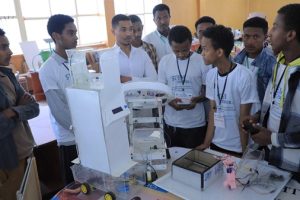
BY SOLOMON WASSIHUN
We are in the second holiday season in the Ethiopian calendar. Four months ago, during the first holiday season back in September, we celebrated New Year’s Day [St John’s Day], Meskel and Irreechaa. Now we are back into yet another holiday season when we observed the two big holidays Orthodox Christmas [Genna] and Epiphany [Timket].
Even though the two holidays are observed in the other part of the Christian world, the way they are celebrated in Ethiopia is quite unique. Ethiopia’s uninterrupted existence for three thousand years as an independent nation-state has hugely contributed to the uniqueness of the traditional and spiritual life of the people.
The original styles of celebration of Christmas [Genna] and Timket are conspicuous in places where most of the Ethiopian population resides in the country side and the remote regional towns relatively less affected by the invasion of foreign culture. A little over a week ago, the holy town of Lalibela was in the media spotlight, as it was the epicenter of the Genna celebration packed with a congregation of laities from across the country and abroad.
Few dared to hope Lalibela, dubbed as the second Jerusalem by Ethiopian Christians, would be ready for this year’s Christmas to stage the colorful Christmas celebration. That was because the town was a site of a fierce mechanized battle until Genna was only two weeks away.
Eventually, Lalibela managed to be the venue for the Christmas celebration as always, despite all the misfortunes and odds. That proved the resilience of the residents in the town, the church, the government officials, and other stakeholders to bring life back to a semblance of normalcy.
The climactic moment of the Genna celebration at Lalibela is the blissful procession of Beza Kulu the religious dance of the priest in praise of the birth of The Holy Savior. The performance is held at the dawn of Christmas Day, the time when Jesus was believed to have been born.
Beza Kullu, meaning the Savior of all, involves a uniquely choreographed mesmerizing performance by an army of hundreds of priests in white turbans and black cloak, dancing to a uniquely Ethiopian chant composed by St Yared over 1500 years ago. Several TV stations and social media channels carry the major Christmas live around the world, to be viewed by millions.
Twelve days after Genna’s celebration comes the Ethiopian Epiphany, Timket. Ethiopian Christians observe Timket essentially outdoors in communion. It is the most spectacular religious festival of the year for Ethiopian Orthodox Christians. Timket is not as such a one-day holiday as
it is indicated in the calendar. It is a three-day festival starting from Ketera, the eve of the holiday, and ends a day after the holiday with the feast of Cana of Galilee [Kana ze Gelila].
The Timket eve, Ketera, is celebrated almost equally to the Timket itself. One thing that sets Timket aside from other holidays is, it is a time when all the replicas of the Ark of the Covenant, Tabots, are brought out into the open from their secluded location inside the church. The Tabots spend a night together in a tent in an open field near a lake/river or an artificial reservoir of water called [timkete-bahir], meaning The Sea of Timket. This is a reenactment of a major biblical event relating to the baptism of Jesus in the Jordan River.
With the entourage of priests and thousands of chanting and ululating laities, the Tabots move in a spectacular procession from their respective churches of permanent placement to the Timket–Bahir during the late afternoon of Epiphany eve.
A tourist who for the first time witnessed the Timket procession wrote: “Priests and Deacons, bearing golden–rimmed silk robes and umbrellas, perform rollicking dances and songs. Accompanied by a slowly building tempo of drums, strums, and pilgrims’ clapping, they [The priests] lead the crowd in an immensely moving procession. All these remind me of scenes described in the Bible when the Israelis welcome Moses upon his return from Mount Sinai carrying the Ten Commandments.”
Timket is in away showcases how Ethiopians Orthodox Christians take their religion seriously. On the night of the Epiphany eve, the laities spend the night lying on the open field, circling the tent where the Tabots are placed, attending the liturgy of the priest, Mahlet that went through the night.
On the morning of the Epiphany day, one of the most exhilarating and crucial of Timket’s events took place at the Temket-bahir. As an act of renewal for their baptism vows, almost half of the Ethiopian populations converge around a nearby Timkete-Bahir in their respective localities and towns. They rub shoulders, vying to get their fair share of the holy water that is splashed by the priests and their aids.
Then a few hours later, the procession for the return of the Tabots to their respective churches begins in a similarly colorful and vibrant procession like that of the previous day. During the three days of the Timket celebration, some people give free food and drinks like the traditional liquor Tela on the street side to everyone. Others provide monetary donations to the beggars. People, who made a vow and received the answer to their request, pay their vows to the church in cash or kind on Timket day.
On Timket Day, Ethiopian Orthodox Christians look their best and dress to kill. Even they have a saying which is roughly translated as “A dress that is not good enough and not available to be worn on Timket day, should well be torn out and discarded.” It is common in Timket to see several groups of young men and women with the same outfits, shoes, and hairstyles.
Timket provides a venue for the young to show off their vocal and dancing talents. Moreover, it is also a good time for bachelors to select their future wives as all the girls get a rare opportunity to stay outside home to celebrate the holiday. Back in the older days, young men go to the Timket festival with lemons in their hands. And they throw them to the girls they like, as a way of expression of their desire.
As Lalibela is to Genna, so is Gondar to Timket. The historic city of Gondar often called the Camelot of Africa is the venue for the biggest and the most spectacular celebration of Timket. Gondar is renowned as the home to 44 different Tabots and boasts the iconic 17-century Fasiledes Castle, where the magnificent Ketera ceremony of the Timket festival takes place. Every year, on Timket week, Gondar is inundated with pilgrims and thrill-seeking tourists from around the world.
We are in the mid of January, a month of festivity like September. At this time of year, the barn is fuller, the cattle are fatter, and the farmers are less busy and have reaped the produce they have been toiling for months. And of course, the weather is balmy, ideal for extended out-door activities. With the majority of the Ethiopian population being a farming community, most of us are more likely to celebrate Genna and Timket more lavishly than other holidays. In addition, many of the weddings take place during this festive season, this month. The dancing and ululating would continue throughout January and beyond, long after the sounds of the church bugles, jumbo drums, and strums receded.
The Ethiopian Herald January 23/2022





